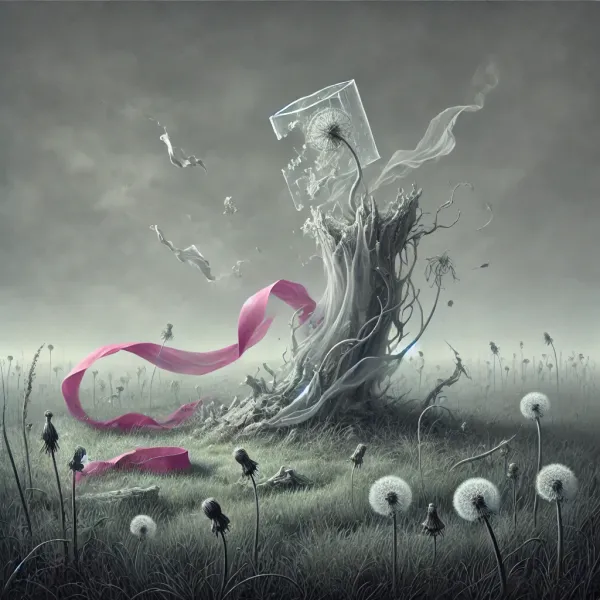The Art of Letting Go Without Falling Apart
Transformation isn’t subtraction. It’s not about taking something out to make space. It’s the reconfiguration itself that changes everything. Letting go isn’t absence, it’s a shift in how things relate so something new can begin.

In my last piece, I wrote about scaffolds—those temporary structures we build to support growth—and the quiet power they hold even after their purpose has passed. I explored how what begins as a gesture of support often becomes an invisible constraint, and how care sometimes means stepping aside. I ended with the thought that ethical design does not only involve building well, but also knowing when to let go.
We treat transformation as a matter of subtraction, but it is a non-linear equation.
Letting go is a phrase we hear often in the business world, though rarely in the way I mean it here. More often than not, “letting go” becomes a euphemism for dismissing people. We downsize, restructure, reposition. We assume that for something new to emerge, someone must leave. That’s how we treat transformation. As a matter of subtraction. A person out, a new process in. And yet, we seldom ask if perhaps it is the process that should have left, not the person.
But transformation isn’t subtraction. And it isn’t addition either. It’s not a linear equation. It doesn’t follow the rules of basic arithmetic, where one thing is removed, another inserted, and the result remains balanced.
Real transformation behaves more like a shift in dimension, something changes in the way parts relate, in the rules that govern interaction, in what becomes possible at all.
It is the form itself that alters, not just the content.
This isn’t to say that people do not resist change. Of course they do. So do I and pretty likely, so do you. But I have also seen people adapt, learn, go beyond what even they thought possible. People change all the time, especially when they are given space to do so. So when change stalls in organizations, I wonder if it is truly only the people, or the structures they are wrapped in.
Because a person cannot fly if you keep tying their wings back into the same procedural loop.
We underestimate how much of what we call “resistance” is simply a response to a space that hasn’t changed. Processes live on long after their usefulness has passed. Decision trees, approval workflows, reporting lines, planning cycles are surely all built with the best intentions, but at some point calcified into routines no one dares to question.
We do not notice when a scaffold becomes a wall.
Letting go, in this sense, is not about losing people. It is about releasing the rituals, policies, and inherited expectations that no longer serve what we claim to care about.
And yet, we hesitate. Not because we love the structures themselves, but because we fear what their absence might do. What happens if we loosen control? What happens if we undo the process before a new one is ready? In complexity, these are legitimate concerns. When the future cannot be mapped, unbuilding feels dangerous. There is no guarantee that something better will replace what we remove.
But here is the paradox: the longer we wait to dismantle what no longer works, the less trust we have in our ability to act at all. We begin to manage symptoms instead of causes. We start to decorate the cage. We optimize, we rename, we digitize, we do literally anything but release. And slowly, the decision-making space contracts, until it becomes a space of avoidance rather than orientation.
The art of letting go is learning to pause between the old and the new, and to trust that a temporary absence is not the same as a vacuum.
The art of letting go, then, is not the art of dismantling everything. It is the art of identifying the scaffolds that have overstayed, the support systems that have turned into burdens, the clarity that has hardened into dogma. It requires the courage to ask: what would we never question here? And what would happen if we did?
Wise decision-making in complexity is less about having the right answer and more about recovering the capacity to ask the right questions. It is about reopening the space of possibility, without rushing to fill it with new plans too quickly. It is about learning to pause between the old and the new, and to trust that a temporary absence is not the same as a vacuum.
Letting go without falling apart means shifting our orientation. Away from permanence and toward permission. Away from legacy and toward liveliness. It means recognizing that our structures are not sacred, but contingent. And that every process, no matter how beloved or embedded, should be held lightly enough to release.
It is not easy work. There will be moments of disorientation. There will be blank spaces on the calendar and awkward silences in meetings. There may be people who ask, “What are we doing?” and you will have to answer, “We are making room.” But that is not a collapse. That is a beginning.
Because nothing alive holds its breath forever. Even systems must exhale.
Hi,
I am Eva Tomas Casado, futurist by nature, engineer by training, and philosopher by heart. With Simple Thinking, I am exploring the intersections of these three realms to build new ways of acting on present complexities into the futures. Join me! Or reach out and let's have a conversation, about how we could apply these ideas to your life, your environment, organization, or company, or ecosystem.




